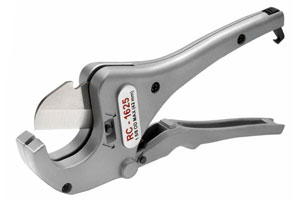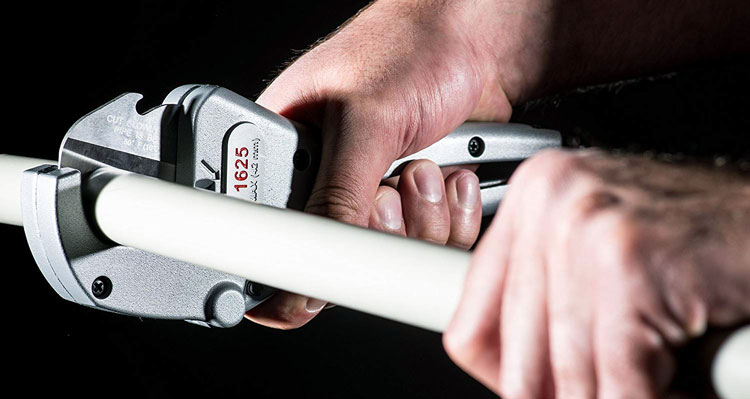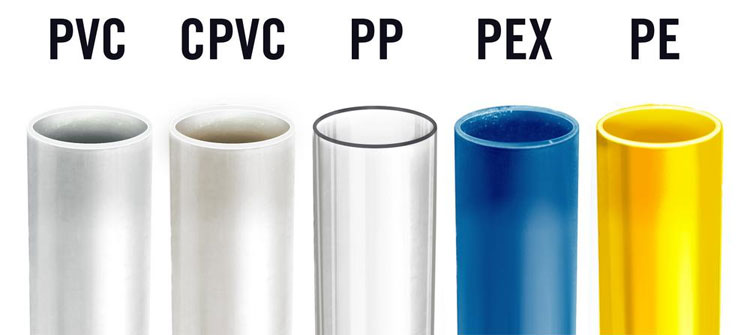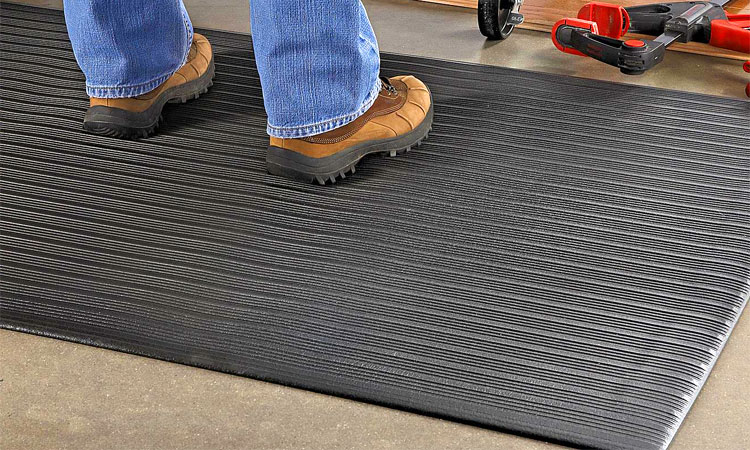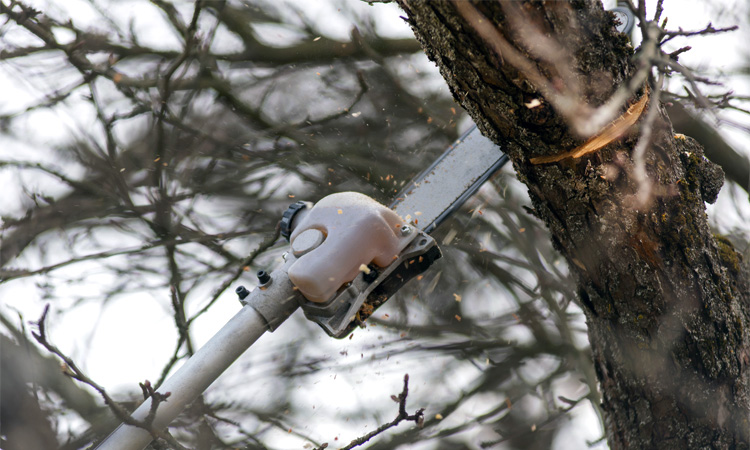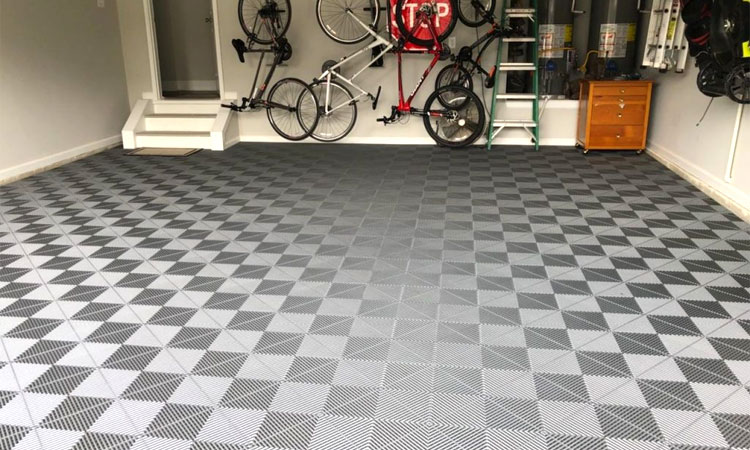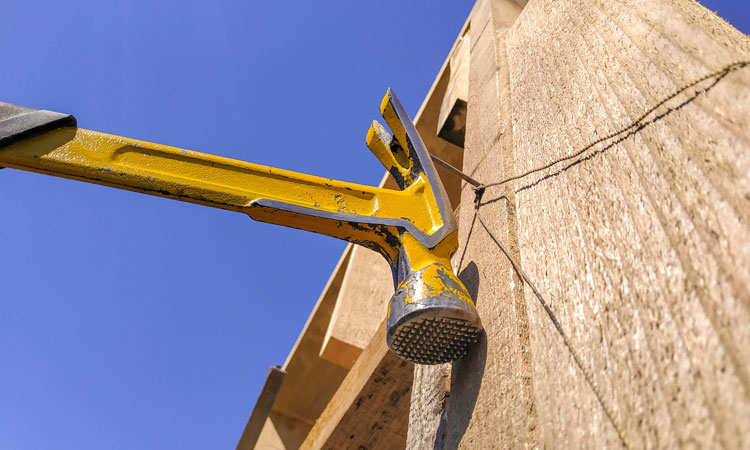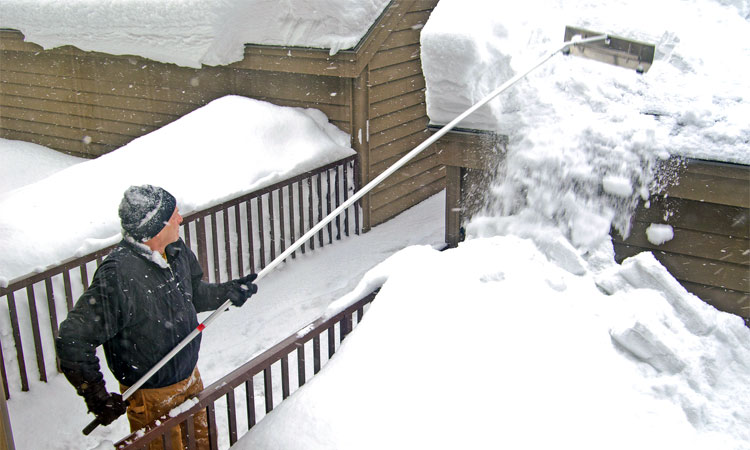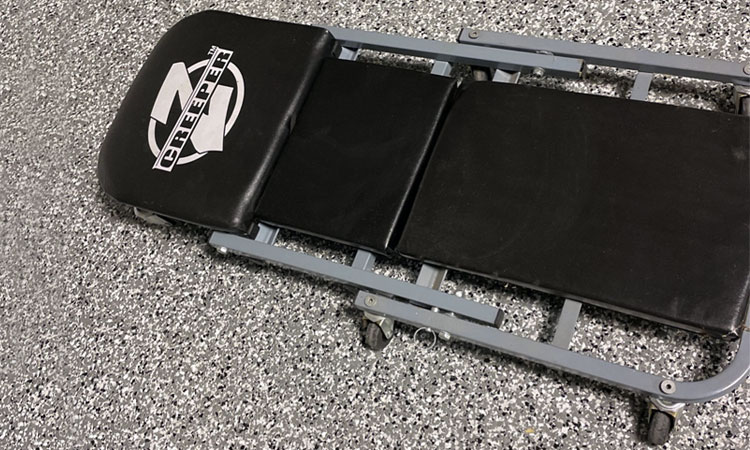7 Best PVC Pipe Cutters (for Professional and Home Use)
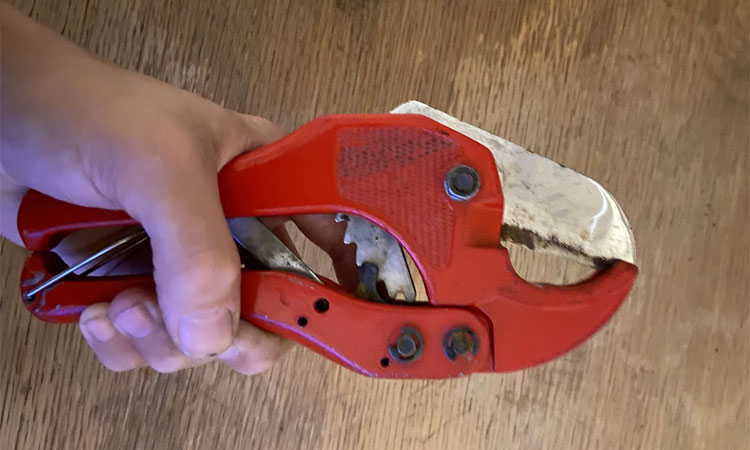
Back in the day, you needed more than one pipe and tubing cutter in your toolbox to handle the wide range of metal and composite materials.
Today, the vast majority of pipes use PVC or CPVC, and most tubing is constructed using PEX. As a result, you need far fewer cutting tools and generally upgrade from older materials as needed.
With the increase of modern home DIYers, these tools are no longer just for professional plumber use. Here are seven of the best PVC pipe cutters currently available.
Our 7 Favorites
| Product | Type | Max OD | Use | |
|---|---|---|---|---|
| Ridgid RC-1625 | Ratchet | 1-5/8" | Professional | |
| Rothenberger RoCut 52000 | Ratchet | 1-5/8" | Professional | |
| Milwaukee M12 2470-20 | 12v Cordless | 2" | Professional | |
| Klein Tools 50031 | Ratchet | 1-5/8" | Professional | |
| Ridgid PC-1250 | Single Stroke | 1-5/8" | Home | |
| Husky 16PL0101-1 | Ratchet | 1-5/8" | Home | |
| Ginzors PVC Cutter | Ratchet | 1-1/4" | Home |
PVC Pipe Cutter Reviews
#1 – Ridgid 23498 RC-1625 Plastic Pipe and Tube Cutter
As one of the most widely used PVC pipe cutters for plumbers, contractors, and other professionals, the Ridgid RC-1625 is designed to handle a wide range of materials, including PVC, CPVC, PEX, ABS, PE, PP, rubber hose, and multilayer tubing.
The ergonomic grips are set at 1/2 inch intervals to double as a pipe measuring scale. It features an X-CEL quick change blade design, making it possible to swap blades in mere seconds without the need for tools or the risk of losing fittings.
You’ll get excellent burr-less cuts, thanks to the ratcheting mechanism and advanced blade design. The tool has a 1/8 to 1-5/8 inch outer diameter cutting capacity, allowing it to work on most pipes with equal efficiency. Best of all, the product is covered by RIDGID’s limited lifetime warranty, ensuring the tool you get is completely free of defects.
There’s a lot to love about this tool. Beyond the easy-to-use design and tool-less blade changing, the tool does its job in style. The aluminum construction makes it lightweight while being built to take abuse and has a nice chrome finish. The blades are incredibly sharp, making cutting a breeze. It’s certainly one of, if not the best ratcheting PVC pipe cutter out there.
There are a few minor downsides to this tool, however. One common sticking point (like most of the competition) is that it won’t handle 1.5 inch pipe (these actually have an outer diameter of 1.9 inches). For that you’ll need to move up to the RC-2375 which handles up to 2-3/8″ OD.
The springs can also be a little tricky at times due to their sensitivity. A good knock can occasionally dislodge them, requiring you to disassemble the tool and reset them. It can also be a little difficult to start cuts due to the rounded profile of the bottom jaw until you’re used to handling the tool.
Finally, the blade is designed to spring fully open every time, meaning you have to readjust it to the pipe size you’re working with each time when cutting multiple pipes. This last point isn’t a problem for someone who plans to use this pipe and tubing cutter for primarily cutting PVC, but may be annoying for those who want something they can set and forget.
But even with these small annoyances, the Ridgid has one of the best combinations of quality, performance, and price. Great for pros and or that next do-it-yourself project.
>> Check current price <<
#2 – Rothenberger RoCut 42TC 52000 Plastic Pipe Shears
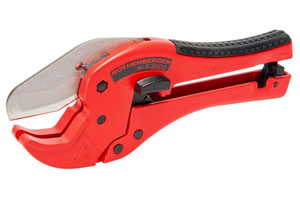
A blade release button makes it easy to operate the tool one-handed, while the ergonomic handle adds to the tool’s durability and allows for longer work periods. Transport is made safer, thanks to a lockable lever.
This is one of the best professional PVC pipe cutters you’ll find and is a favorite of many contractors. Its V-edge triangular blade and squared bottom jaw provide superior grip and cut to other models, and the overall design prevents that annoying urge to twist on the last stroke that’s so common in other models.
Of course, no tool is perfect (or these lists wouldn’t be needed) and the Rothenberger is no exception. The release button is made of plastic, creating a weak point in the otherwise stainless steel construction.
This part is prone to breaking and must be used for each cut, meaning it gets a lot of stress. Warming an older pipe with a heat gun before cutting it can help reduce the risk of damaging the tool. Also, be sure to give the tool a little oil now and then, as it can still suffer oxidation when not given a little common-sense care.
>> Check current price <<
#3 – Milwaukee M12 2470-20 Cordless PVC Shear
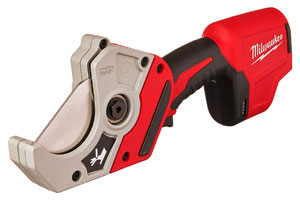
Its quick blade return increases productivity while the blade’s design allows cutting close to a wall without burrs. You can cut ABS, BlazeMaster, CPVC, non-metallic conduit, PEX, PVC, and rubber hose more than 200 times on a single charge.
The tool is part of the popular Milwaukee M12 lineup and shares the same Lithium-Ion batteries as the other 100+ M12 power tools. The 2470-20 powered pipe cutter has an all-metal planetary drive to ensure a long, reliable lifespan.
This cutter fits into some pretty tight spaces, making it more practical than much of its direct competitors. At the same time, it cuts quick, clean, and square with very little additional effort on your part. Maintenance is as simple as a squirt of WD-40 here and there to keep it well-lubed and sharp.
Be warned that the cutting head is larger to accommodate thicker pipe, so the spaces it can fit in are a little restricted vertically. Thicker pipes also take a little more effort and finesse than regular 3/4 to 1-1/4 inch pipe, leading to a lot of complaints about flawed cuts from those not prepared for the challenge.
The design also means this tool is heavier than it appears and it may be a little more difficult to work the safety when you’re left-handed.
>> Check current price <<
#4 – Klein Tools 50031 PVC Cutter
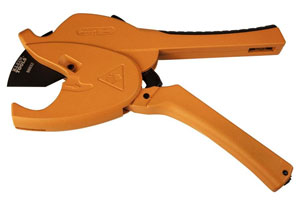
The 50031 is a durable pipe cutter made out of aluminum that creates straight cuts in 1/2 to 1-1/4 inch PVC with very little effort. It includes a fast one-handed blade release and ratchet mechanism so you don’t have to let go of the pipe while working and includes an easy tool-less blade change.
A lot of pipe cutters claim to be made for one-handed use, but you can really feel the quality in the Klein. This excellent tool is incredibly easy to use and is built to last, making it a great go-to tool for anyone who does a lot of work with plastic piping.
The steel blade can be a little difficult to line up until you’re used to the tool due to the design. It can also be a little awkward to handle compared to other tools. Again, experience makes using this tool easier over time, but it might not provide the ideal experience your first couple tries.
>> Check current price <<
#5 – Ridgid 23488 PC-1250 Plastic Pipe and Tubing Cutter
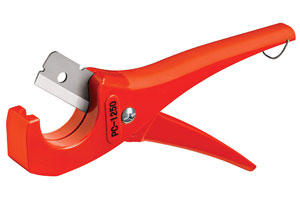
Arguably the best PVC pipe cutter for home use, the Ridgid PC-1250 is frequently recommended in the DIY community for its excellent cutting performance at a low price point.
This pipe cutter is able to cut CPVC, PE, PEX, PP, and PVC pipe between 1/8 and 1-5/8 inches in outer diameter. Its spring-loaded handles make positioning of this scissor-style cutter easier and allows for convenient single-stroke cuts. The compact size makes it easier to store and transport.
In addition to RIGID’s limited lifetime warranty, this cutter has added value with the convenient reversible blade design, giving twice the blade life as the competition.
The X-cel blade is accompanied with a quick change design so you never have to pause work for long when swapping out or flipping the blades. Note that this tool isn’t designed to cut multilayer tubing.
The little brother of our top pick, this Ridgid is designed with tubing in mind, although it will also work well on pipe. This means it can cut through even pressure hoses like butter.
It’s very light and fits into tight spaces with little trouble. While you’ll likely be using this tool for tubing, the added spring ensures the handle opens nice and wide to accommodate larger pipes.
While high quality and quite durable, the plastic design of this product may prove worrisome to many users. It can get a little wobbly at the hinge over time, affecting the straightness of your cuts. It’s unknown if this can be tightened, but certainly leads to breakage if not fixed. But for its price, buying a new one is easily affordable if you eventually wear it out.
Also, be warned that this tool is insanely sharp and requires very little pressure to use, so avoid applying too much pressure too fast unless you wish to get pinched or risk cutting yourself.
>> Check current price <<
#6 – Husky 16PL0101-1 Ratcheting PVC Cutter
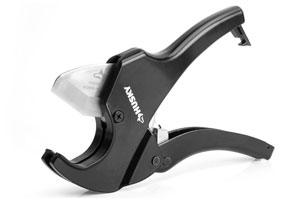
Built from aluminum with a steel blade, this cutter is both lightweight and durable. The Husky features a one-handed quick change blade and ratcheting mechanism to get the job done quickly. It also comes with Husky’s lifetime warranty, ensuring you’ll be able to use this tool for many years to come.
This tool is easy to use and has an incredibly sharp blade that cuts like a knife through hot butter, according to many owners. Cuts are clean and straight, even when used one-handed. One of its best features, the quick change blade is as simple as pushing the new blade in until it clicks.
The blade works quite well with Schedule 40 PVC, but can wear down quickly with Schedule 80. Some owners say that the handle is designed for a larger hand, which makes it a little frustrating to use for individuals with small hands.
>> Check current price <<
#7 – Ginzors Ratcheting PVC and Hose Cutter
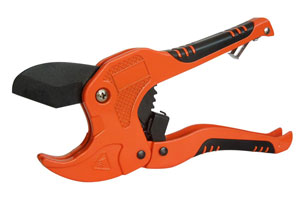
Made from high quality manganese steel with a sharp teflon blade, this one-handed ratcheting PVC cutter will cut 1/2 to 1-1/4 inch diameter PVC. It includes a soft rubber handle for easier grip and a stainless steel buckle to lock the blade when not in use. The blade is able to cut aluminum, CPVC, PEX, PPR, PVC, and rubber hose.
This tool works well in tight spaces and makes clean, fast cuts. It’s surprisingly light for having steel construction and feels nice and sturdy. It also feels quite natural when using the tool one-handed, unlike many similar models which tend to be better suited for right-handers or allow single-handed use almost as an afterthought.
The teflon blade may be razor sharp, but it’s also much thinner than standard steel blades, which can cause it to flex during a cut. It has also been known to crush softer pipe, rendering it useless. Another flaw that’s been reported is the exposure of a spring when the buckle is opened. The tip of this spring is very sharp and may cause injury when not handled carefully.
While not the top model out there, it’s one of the best non-brand name cutters out there and can be had for cheap, especially when it’s on sale.
>> Check current price <<
FAQs
Even though we’ve narrowed the field to seven of the best PVC pipe cutters out of literally dozens of choices, it can be a matter of personal preference to find the one that’s right for you.
The following questions are sticking points even a professional plumber might ask when choosing their first PVC cutter.
Related: PVC Pipe Sizes Charts
Ratcheting vs Non-Ratcheting – Which is Better?
Generally speaking, ratcheting PVC pipe cutters with a steel blade will make the job easier. These reduce the risk of slippage and thus allow for faster work than with a non-ratcheting model.
While the non-ratcheting cutters are usually cheaper and still highly effective, unless you’re consistently working with small diameter tubing or hoses, experts tend to recommend spending the extra money when possible to get a good ratcheting version.
What Can You Cut With a PVC Pipe Cutter?
Obviously, you can cut PVC (polyvinyl chloride) piping with this type of cutter. But in addition, most PVC pipe cutters will also slice through CPVC (chlorinated polyvinyl chloride), PP (polypropylene), PEX (cross-linked polyethylene), and PE (ppolyethylene) piping and tubing.
Some cutters can also cut PB (polybutylene) and PVDF (polyvinylidene fluoride) piping.
In addition, PVC pipe cutters work great for cleanly cutting all sorts of hoses such as garden hoses, air compressor hoses, automotive vacuum hoses, drip irrigation hoses, and many others.
See Also: Common PEX Pipe Sizes (with Chart)
Can You Cut PVC with a Copper Pipe Cutter?
Believe it or not, copper pipe cutters work quite well on PVC. They can also be used on ABS, CPVC, and EMT.
The downside to using this tool is that the blade was designed specifically for copper and will dull quickly when used on any material other than copper, making it less cost effective if you plan on using them as a PVC or CPVC cutter often.
Can You Use Other Alternative Tools to Cut PVC?
PVC pipe cutters are designed for use on new pipe and thus can result in shattering or other damage to older, worn lengths of pipe. For these pipes, it’s sometimes best to stick with the tried-and-true hacksaw (or a reciprocating saw, if you prefer power tools). Miter saws are also an excellent option when cutting pipe that has yet to be installed.
A few more specialized alternatives are chop saws, internal PVC pipe cutters, and (when in a pinch) pencil grinders. These tools can be more expensive or harder to use, thus it’s likely you will never pick these latter options.

